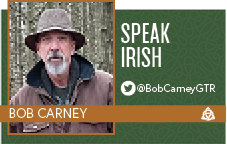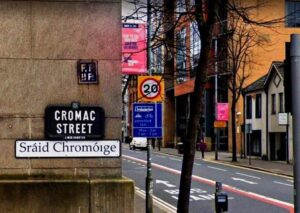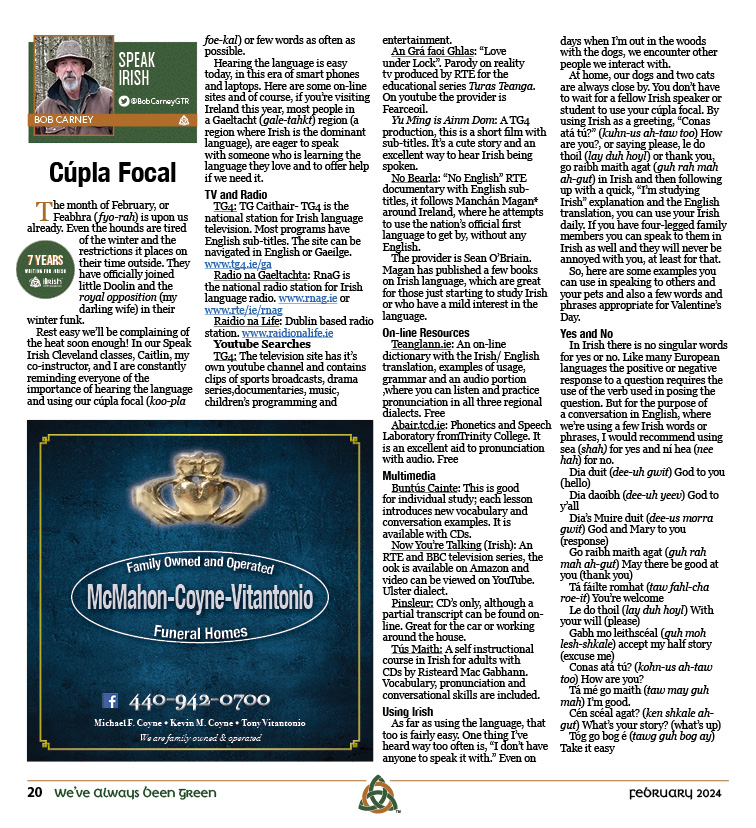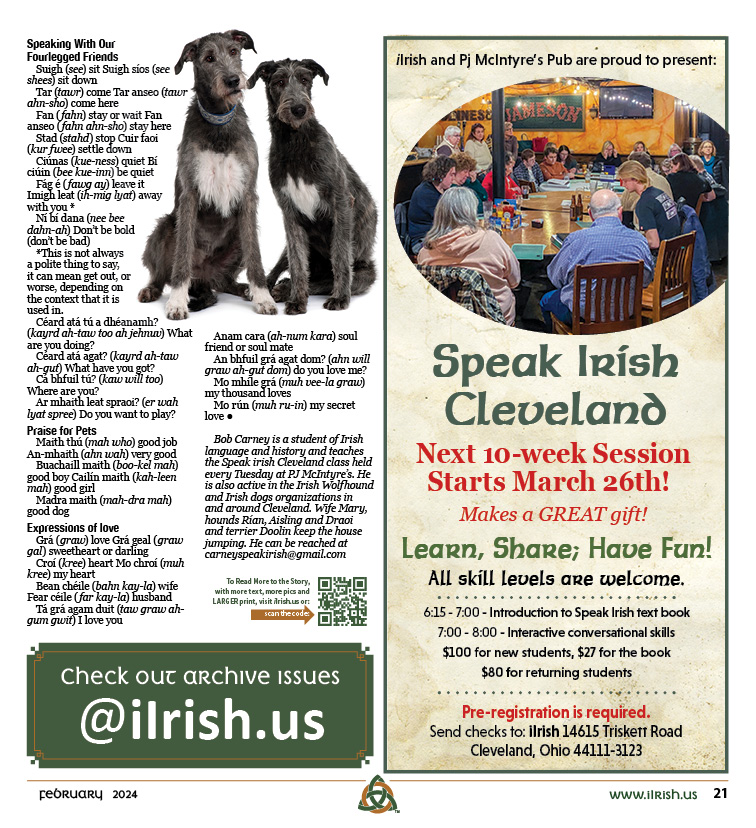

By Bob Carney
The month of February, or Feabhra (fyo-rah) is upon us already. Even the hounds are tired of the winter and the restrictions it places on their time outside. They have officially joined little Doolin and the royal opposition (my darling wife) in their winter funk.
Rest easy we’ll be complaining of the heat soon enough! In our Speak Irish Cleveland classes, Caitlin, my co-instructor, and I are constantly reminding everyone of the importance of hearing the language and using our cúpla focal (koo-pla foe-kal) or few words as often as possible.
Hearing the language is easy today, in this era of smart phones and laptops. Here are some on-line sites and of course, if you’re visiting Ireland this year, most people in a Gaeltacht (gale-tahkt) region (a region where Irish is the dominant language), are eager to speak with someone who
is learning the language they love and to offer help if we need it.
TV and Radio
TG4: TG Caithair- TG4 is the national station for Irish language television. Most programs have English sub-titles. The site can be navigated in English or Gaeilge. www.tg4.ie/ga
Radio na Gaeltachta: RnaG is the national radio station for Irish language radio. www.rnag.ie or www.rte/ie/rnag
Raidio na Life: Dublin based radio station. www.raidionalife.ie
Youtube Searches
TG4: The television site has it’s own youtube channel and contains clips of sports broadcasts, drama series,documentaries, music, children’s programming and entertainment.
An Grá faoi Ghlas: “Love under Lock”. Parody on reality tv produced by RTE for the educational series Turas Teanga. On youtube the provider is Fearceoil.
Yu Ming is Ainm Dom: A TG4 production, this is a short film with sub-titles. It’s a cute story and an excellent way to hear Irish being spoken.
No Bearla: “No English” RTE documentary with English sub-titles, it follows Manchán Magan* around Ireland, where he attempts to use the nation’s official first language to get by, without any English.
The provider is Sean O’Briain. Magan has published a few books on Irish language, which are great for those just starting to study Irish or who have a mild interest in the language.
On-line Resources
Teanglann.ie: An on-line dictionary with the Irish/ English translation, examples of usage, grammar and an audio portion ,where you can listen and practice pronunciation in all three regional dialects. Free
Abair.tcd.ie: Phonetics and Speech Laboratory fromTrinity College. It is an excellent aid to pronunciation with audio. Free
Multimedia
Buntús Cainte: This is good for individual study; each lesson introduces new vocabulary and conversation examples. It is available with CDs.
Now You’re Talking (Irish): An RTE and BBC television series, the book is available on Amazon and video can be viewed on YouTube. Ulster dialect.
Pinsleur: CD’s only, although a partial transcript can be found on-line. Great for the car or working around the house.
Tús Maith: A self instructional course in Irish for adults with CDs by Risteard Mac Gabhann. Vocabulary, pronunciation and conversational skills are included.
Using Irish
As far as using the language, that too is fairly easy. One thing I’ve heard way too often is, “I don’t have anyone to speak it with.” Even on days when I’m out in the woods with the dogs, we encounter other people we interact with.
At home, our dogs and two cats are always close by. You don’t have to wait for a fellow Irish speaker or student to use your cúpla focal.
By using Irish as a greeting, “Conas atá tú?” (kuhn-us ah-taw too) How are you?, or saying please, le do thoil (lay duh hoyl) or thank you, go raibh maith agat (guh rah mah ah-gut) in Irish and then following up with a quick, “I’m studying Irish” explanation and the English translation, you can use your Irish daily. If you have four-legged family members, you can speak to them in Irish as well and they will never be annoyed with you, at least for that.
So, here are some examples you can use in speaking to others and your pets and also a few words and phrases appropriate for Valentine’s Day.
Yes and No
In Irish there is no singular words for yes or no. Like many European languages the positive or negative response to a question requires the use of the verb used in posing the question. But for the purpose of a conversation in English, where we’re using a few Irish words or phrases, I would recommend using sea (shah) for yes and ní hea (nee hah) for no.
Dia duit (dee-uh gwit) God to you (hello)
Dia daoibh (dee-uh yeev) God to y’all
Dia’s Muire duit (dee-us morra gwit) God and Mary to you (response)
Go raibh maith agat (guh rah mah ah-gut) May there be good at you (thank you)
Tá fáilte romhat (taw fahl-cha roe-it) You’re welcome
Le do thoil (lay duh hoyl) With your will (please)
Gabh mo leithscéal (guh moh lesh-shkale) accept my half story (excuse me)
Conas atá tú? (kohn-us ah-taw too) How are you?
Tá mé go maith (taw may guh mah) I’m good.
Cén scéal agat? (ken shkale ah-gut) What’s your story? (what’s up)
Tóg go bog é (tawg guh bog ay) Take it easy

Speaking With Our Fourlegged Friends
Suigh (see) sit
Suigh síos (see shees) sit down
Tar (tawr) come
Tar anseo (tawr ahn-sho) come here
Fan (fahn) stay or wait
Fan anseo (fahn ahn-sho) stay here
Stad (stahd) stop
Cuir faoi (kur fwee) settle down
Ciúnas (kue-ness) quiet
Bí ciúin (bee kue-inn) be quiet
Fág é (fawg ay) leave it
Imigh leat (ih-mig lyat) away with you *
Ní bí dana (nee bee dahn-ah) Don’t be bold (don’t be bad)
*This is not always a polite thing to say, it can mean get out, or worse, depending on the context that it is used in.
Céard atá tú a dhéanamh? (kayrd ah-taw too ah jehnuv) What are you doing?
Céard atá agat? (kayrd ah-taw ah-gut) What have you got?
Cá bhfuil tú? (kaw will too) Where are you?
Ar mhaith leat spraoi? (er wah lyat spree) Do you want to play?
Praise for Pets
Maith thú (mah who) good job An-mhaith (ahn wah) very good
Buachaill maith (boo-kel mah) good boy
Cailín maith (kah-leen mah) good girl
Madra maith (mah-dra mah) good dog
Expressions of love
Grá (graw) Love
Grá geal (graw gal) sweetheart or darling
Croí (kree) Heart
Mo chroí (muh kree) my heart
Bean chéile (bahn kay-la) wife
Fear céile (far kay-la) husband
Tá grá agam duit (taw graw ah-gum gwit) I love you
Anam cara (ah-num kara) soul friend or soul mate
An bhfuil grá agat dom? (ahn will graw ah-gut dom) do you love me?
Mo mhíle grá (muh vee-la graw) my thousand loves
Mo rún (muh ru-in) my secret love
Slán go fóill




See this and all of Bob’s columns HERE

*Bob Carney is a student of Irish language and history and teaches the Speak Irish Cleveland class held every Tuesday at PJ McIntyre’s. He is also active in the Irish Wolfhound and Irish dogs organizations in and around Cleveland. Wife Mary, hounds Rían, Aisling and Draoi and terrier Doolin keep the house jumping. He can be reached at [email protected]
ends



Monthly newsmagazine serving people of Irish descent from Cleveland to Clearwater. We cover the movers, shakers & music makers each and every month.
Since our 2006 inception, iIrish has donated more than $376,000 to local and national charities.
GET UPDATES ON THE SERIOUS & THE SHENANIGANS!